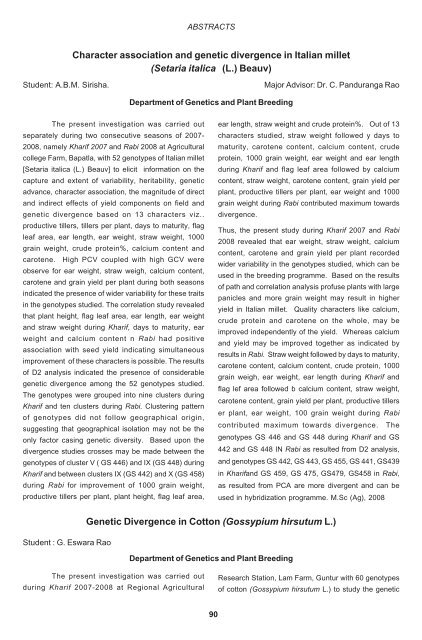physicochemical
Contents of 39(1 & 2) 2011 - acharya ng ranga agricultural university
Contents of 39(1 & 2) 2011 - acharya ng ranga agricultural university
- No tags were found...
You also want an ePaper? Increase the reach of your titles
YUMPU automatically turns print PDFs into web optimized ePapers that Google loves.
ABSTRACTS<br />
Character association and genetic divergence in Italian millet<br />
(Setaria italica (L.) Beauv)<br />
Student: A.B.M. Sirisha.<br />
Major Advisor: Dr. C. Panduranga Rao<br />
Department of Genetics and Plant Breeding<br />
The present investigation was carried out<br />
separately during two consecutive seasons of 2007-<br />
2008, namely Kharif 2007 and Rabi 2008 at Agricultural<br />
college Farm, Bapatla, with 52 genotypes of Italian millet<br />
[Setaria italica (L.) Beauv] to elicit information on the<br />
capture and extent of variability, heritability, genetic<br />
advance, character association, the magnitude of direct<br />
and indirect effects of yield components on field and<br />
genetic divergence based on 13 characters viz..<br />
productive tillers, tillers per plant, days to maturity, flag<br />
leaf area, ear length, ear weight, straw weight, 1000<br />
grain weight, crude protein%, calcium content and<br />
carotene. High PCV coupled with high GCV were<br />
observe for ear weight, straw weigh, calcium content,<br />
carotene and grain yield per plant during both seasons<br />
indicated the presence of wider variability for these traits<br />
in the genotypes studied. The correlation study revealed<br />
that plant height, flag leaf area, ear length, ear weight<br />
and straw weight during Kharif, days to maturity, ear<br />
weight and calcium content n Rabi had positive<br />
association with seed yield indicating simultaneous<br />
improvement of these characters is possible. The results<br />
of D2 analysis indicated the presence of considerable<br />
genetic divergence among the 52 genotypes studied.<br />
The genotypes were grouped into nine clusters during<br />
Kharif and ten clusters during Rabi. Clustering pattern<br />
of genotypes did not follow geographical origin,<br />
suggesting that geographical isolation may not be the<br />
only factor casing genetic diversity. Based upon the<br />
divergence studies crosses may be made between the<br />
genotypes of cluster V ( GS 446) and IX (GS 448) during<br />
Kharif and between clusters IX (GS 442) and X (GS 458)<br />
during Rabi for improvement of 1000 grain weight,<br />
productive tillers per plant, plant height, flag leaf area,<br />
ear length, straw weight and crude protein%. Out of 13<br />
characters studied, straw weight followed y days to<br />
maturity, carotene content, calcium content, crude<br />
protein, 1000 grain weight, ear weight and ear length<br />
during Kharif and flag leaf area followed by calcium<br />
content, straw weight, carotene content, grain yield per<br />
plant, productive tillers per plant, ear weight and 1000<br />
grain weight during Rabi contributed maximum towards<br />
divergence.<br />
Thus, the present study during Kharif 2007 and Rabi<br />
2008 revealed that ear weight, straw weight, calcium<br />
content, carotene and grain yield per plant recorded<br />
wider variability in the genotypes studied, which can be<br />
used in the breeding programme. Based on the results<br />
of path and correlation analysis profuse plants with large<br />
panicles and more grain weight may result in higher<br />
yield in Italian millet. Quality characters like calcium,<br />
crude protein and carotene on the whole, may be<br />
improved independently of the yield. Whereas calcium<br />
and yield may be improved together as indicated by<br />
results in Rabi. Straw weight followed by days to maturity,<br />
carotene content, calcium content, crude protein, 1000<br />
grain weigh, ear weight, ear length during Kharif and<br />
flag lef area followed b calcium content, straw weight,<br />
carotene content, grain yield per plant, productive tillers<br />
er plant, ear weight, 100 grain weight during Rabi<br />
contributed maximum towards divergence. The<br />
genotypes GS 446 and GS 448 during Kharif and GS<br />
442 and GS 448 IN Rabi as resulted from D2 analysis,<br />
and genotypes GS 442, GS 443, GS 455, GS 441, GS439<br />
in Kharifand GS 459, GS 475, GS479, GS458 in Rabi,<br />
as resulted from PCA are more divergent and can be<br />
used in hybridization programme. M.Sc (Ag), 2008<br />
Student : G. Eswara Rao<br />
Genetic Divergence in Cotton (Gossypium hirsutum L.)<br />
Department of Genetics and Plant Breeding<br />
The present investigation was carried out<br />
during Kharif 2007-2008 at Regional Agricultural<br />
Research Station, Lam Farm, Guntur with 60 genotypes<br />
of cotton (Gossypium hirsutum L.) to study the genetic<br />
90
















